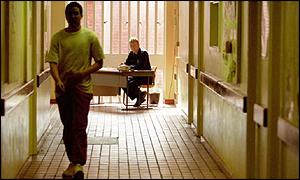If you are between the ages of 15-21, live in Greater London and are charged with committing a serious crime, the likelihood is that you'll end up here. Each year 30,000 young men pass through Feltham's gates, although there are only 600 at any one time. I am visiting because I do some voluntary work in my spare time and have to visit two penal institutions as part of my training. Like most people I have opinions about crime and punishment, but I have never set foot in a prison and I feel nervous, not sure of what I'm going to find.
The visit begins in the vocational training area. This is where offenders ('Although we don't call them that any more' I'm told) can learn skills in painting and decorating, bricklaying and motor mechanics. This is prison at its best, attempting to reform by making the young men here employable. We are allowed to talk to the inmates, sorry, young adults and I'm struck by how likeable most of them are. Where are the resentful stares and killer eyes? Later I discover that one of them is a murderer and won't leave the prison system until 2020.
The workshops are impressive, but 80% of the inmates never attend them. Sometimes this is due to behavioural difficulties, but the main problem in Feltham is that it is a remand centre and very few people stay long enough to make vocational training feasible.
Next we move on to the educational centre. We are warned that the 'lads' may be a little cheeky, as many of them resent the schooling that is compulsory for the under 16s. We enter a long corridor, with classrooms on either side. Instead of internal walls, the classrooms are separated from the corridor by safety glass so that the prison officers can see everything and guarantee the teachers' safety. There are quite a few women in the unit and I wonder how the attractive young cookery teacher handles a roomful of testosterone-fuelled males.
I feel uncomfortable looking through the glass at the inmates, as if they're exhibits in a zoo and I feel relieved when we move on to the induction area, where new offenders spend their first night. At first glance it reminds me of the entrance to a student union bar, but when I realise that the brightly-coloured doors are all cells the reality sinks in. We look at a cell that has been specially designed to prevent 'at risk' prisoners harming themselves. Each cell has its own sink, toilet and televsion, but this is not the soft option that the Daily Mail would like to have us believe. The cell is depressingly bleak. The sink and loo are both dirty and the room stinks of stale tobacco. There used to be 900 inmates in Feltham, but after the notorious incident a few years ago when a racist, psychotic white male killed his Asian roommate, it was decided not to have shared cells any more.
After a brief inspection of the sports hall we end our visit by meeting a member of the management team. Like the other staff we have spoken to she seems refreshingly candid about the problems that Feltham faces and doesn't try to evade any awkward questions. Her prognosis is pretty bleak: most of the inmates have been abused at some point in their lives, many have learning or behavioural difficulties and the grim reality is that most of them will reoffend. Her team do what they can to rescue the more promising individuls, but it an uphill struggle.
I leave Feltham with more questions than answers. Why are at least 80% of the prisoners black? Did we see the real Feltham or a sanitised version? Are the staff as respectful towards the inmates as they claim? But the biggest question of all is why our justice system is unable to do more to rescue young males from a life of crime. Perhaps Ignatius Loyola was right and even 15 is too old to save someone, but that seems a bleak prospect and one that is hard to reconcile with the often likeable young men that I met today.


1 comment:
I agree. Most people I've spoken to say that once most of these lads reach their mid-twenties they settle down, although there is a hard core of recidivists who remain within the system until they're quite old.
I recall Shakespeare saying something about locking up all young men between their early teens and early twenties and Mr Blair's government is well on the way to achieving that target!
Post a Comment